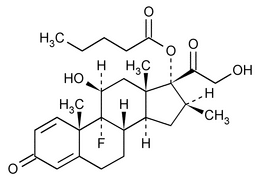Betamethasone Valerate
(bay'' ta meth' a sone val' er ate).
» Betamethasone Valerate contains not less than 97.0 percent and not more than 103.0 percent of C27H37FO6, calculated on the dried basis.
Packaging and storage—
Preserve in tight containers.
Identification—
B:
Thin-Layer Chromatographic Identification Test  201
201 —
—
Test solution:
1 mg per mL, in alcohol.
Developing solvent system:
a mixture of toluene and ethyl acetate (1:1).
Procedure—
Proceed as directed in the chapter. Spray the plate with a mixture of sulfuric acid, methanol, and nitric acid (10:10:1), and heat at 105 for 15 minutes.
for 15 minutes.
Loss on drying  731
731 —
Dry it at 105
—
Dry it at 105 for 3 hours: it loses not more than 0.5% of its weight.
for 3 hours: it loses not more than 0.5% of its weight.
Residue on ignition  281
281 :
not more than 0.2%, a platinum crucible being used.
:
not more than 0.2%, a platinum crucible being used.
Chromatographic purity—
Mobile phase—
Prepare a filtered and degassed mixture of acetonitrile, water, and glacial acetic acid (550:450:1). Make adjustments if necessary (see System Suitability under Chromatography  621
621 ).
).
Test solution—
Transfer about 4 mg of Betamethasone Valerate, accurately weighed, to a suitable flask. Add 10 mL of Mobile phase, and shake until dissolved.
Chromatographic system (see Chromatography  621
621 )—
The liquid chromatograph is equipped with a 254-nm detector and a 4.6-mm × 15-cm column that contains packing L1. The flow rate is about 1 mL per minute. Chromatograph the Test solution, and record the peak responses as directed for Procedure: the resolution, R, between betamethasone valerate and any impurity is not less than 1.5; and the column efficiency is not less than 9000 theoretical plates.
)—
The liquid chromatograph is equipped with a 254-nm detector and a 4.6-mm × 15-cm column that contains packing L1. The flow rate is about 1 mL per minute. Chromatograph the Test solution, and record the peak responses as directed for Procedure: the resolution, R, between betamethasone valerate and any impurity is not less than 1.5; and the column efficiency is not less than 9000 theoretical plates.
Procedure—
Inject a volume (about 10 µL) of the Test solution into the chromatograph, record the chromatogram, and measure all of the peak responses. Calculate the percentage of each impurity in the portion of Betamethasone Valerate taken by the formula:
100(ri / rs)
in which ri is the peak response for each impurity; and rs is the sum of all the peak responses: not more than 1.0% of any individual impurity is found; and not more than 2.0% of total impurities is found.
Assay—
Mobile phase—
Prepare a filtered and degassed mixture of acetonitrile and water (3:2). Make adjustments if necessary (see System Suitability under Chromatography  621
621 ).
).
Internal standard solution—
Transfer about 40 mg of beclomethasone dipropionate to a 100-mL volumetric flask, add a solution of glacial acetic acid in methanol (1 in 1000) to volume, and mix.
Standard preparation—
Transfer about 30 mg of USP Betamethasone Valerate RS, accurately weighed, to a 50-mL volumetric flask, add a solution of glacial acetic acid in methanol (1 in 1000) to volume, and mix. Transfer 5.0 mL of this solution to a suitable stoppered vial, add 10.0 mL of Internal standard solution, and mix to obtain a solution having a known concentration of about 0.2 mg of USP Betamethasone Valerate RS per mL.
Assay preparation—
Transfer about 60 mg of Betamethasone Valerate, accurately weighed, to a 100-mL volumetric flask, add a solution of glacial acetic acid in methanol (1 in 1000) to volume, and mix. Transfer 5.0 mL of this solution to a suitable stoppered vial, add 10.0 mL of Internal standard solution, and mix.
Chromatographic system (see Chromatography  621
621 )—
The liquid chromatograph is equipped with a 254-nm detector and a 4-mm × 30-cm column that contains packing L1. The flow rate is about 1.2 mL per minute. Chromatograph the Standard preparation, and record the peak responses as directed for Procedure: the relative retention times are about 1.7 for beclomethasone dipropionate and 1.0 for betamethasone valerate; the resolution, R, between betamethasone valerate and beclomethasone dipropionate is not less than 4.5; and the relative standard deviation for replicate injections is not more than 2.0%.
)—
The liquid chromatograph is equipped with a 254-nm detector and a 4-mm × 30-cm column that contains packing L1. The flow rate is about 1.2 mL per minute. Chromatograph the Standard preparation, and record the peak responses as directed for Procedure: the relative retention times are about 1.7 for beclomethasone dipropionate and 1.0 for betamethasone valerate; the resolution, R, between betamethasone valerate and beclomethasone dipropionate is not less than 4.5; and the relative standard deviation for replicate injections is not more than 2.0%.
Procedure—
Separately inject equal volumes (about 10 µL) of the Standard preparation and the Assay preparation into the chromatograph, record the chromatograms, and measure the responses for the major peaks. Calculate the quantity, in mg, of C27H37FO6 in the portion of Betamethasone Valerate taken by the formula:
300C(RU / RS)
in which C is the concentration, in mg per mL, of USP Betamethasone Valerate RS in the Standard preparation; and RU and RS are the peak response ratios obtained from the Assay preparation and the Standard preparation, respectively.
Auxiliary Information—
Please check for your question in the FAQs before contacting USP.
| Topic/Question | Contact | Expert Committee |
|---|---|---|
| Monograph | Domenick Vicchio, Ph.D.
Senior Scientific Liaison 1-301-998-6828 |
(SM42010) Monographs - Small Molecules 4 |
| Reference Standards | RS Technical Services 1-301-816-8129 rstech@usp.org |
USP35–NF30 Page 2346
Pharmacopeial Forum: Volume No. 27(5) Page 2980

